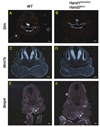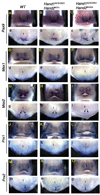Hand transcription factors cooperatively regulate development of the distal midline mesenchyme
- PMID: 17764670
- PMCID: PMC2270479
- DOI: 10.1016/j.ydbio.2007.07.036
Hand transcription factors cooperatively regulate development of the distal midline mesenchyme
Abstract
Hand proteins are evolutionally conserved basic helix-loop-helix (bHLH) transcription factors implicated in development of neural crest-derived tissues, heart and limb. Hand1 is expressed in the distal (ventral) zone of the branchial arches, whereas the Hand2 expression domain extends ventrolaterally to occupy two-thirds of the mandibular arch. To circumvent the early embryonic lethality of Hand1 or Hand2-null embryos and to examine their roles in neural crest development, we generated mice with neural crest-specific deletion of Hand1 and various combinations of mutant alleles of Hand2. Ablation of Hand1 alone in neural crest cells did not affect embryonic development, however, further removing one Hand2 allele or deleting the ventrolateral branchial arch expression of Hand2 led to a novel phenotype presumably due to impaired growth of the distal midline mesenchyme. Although we failed to detect changes in proliferation or apoptosis between the distal mandibular arch of wild-type and Hand1/Hand2 compound mutants at embryonic day (E)10.5, dysregulation of Pax9, Msx2 and Prx2 was observed in the distal mesenchyme at E12.5. In addition, the inter-dental mesenchyme and distal symphysis of Meckel's cartilage became hypoplastic, resulting in the formation of a single fused lower incisor within the hypoplastic fused mandible. These findings demonstrate the importance of Hand transcription factors in the transcriptional circuitry of craniofacial and tooth development.
Figures








References
-
- Abe M, Tamamura Y, Yamagishi H, Maeda T, Kato J, Tabata MJ, Srivastava D, Wakisaka S, Kurisu K. Tooth-type specific expression of dHAND/Hand2: possible involvement in murine lower incisor morphogenesis. Cell Tissue Res. 2002;310:201–212. - PubMed
-
- Aigner T, Dietz U, Stoss H, von der Mark K. Differential expression of collagen types I, II, III, and X in human osteophytes. Lab Invest. 1995;73:236–243. - PubMed
-
- Akiyama H, Shigeno C, Iyama K, Ito H, Hiraki Y, Konishi J, Nakamura T. Indian hedgehog in the late-phase differentiation in mouse chondrogenic EC cells, ATDC5: upregulation of type X collagen and osteoprotegerin ligand mRNAs. Biochem Biophys Res Commun. 1999;257:814–820. - PubMed
-
- Chai Y, Jiang X, Ito Y, Bringas P, Jr, Han J, Rowitch DH, Soriano P, McMahon AP, Sucov HM. Fate of the mammalian cranial neural crest during tooth and mandibular morphogenesis. Development. 2000;127:1671–1679. - PubMed
-
- Chai Y, Maxson RE., Jr Recent advances in craniofacial morphogenesis. Dev Dyn. 2006;235:2353–2375. - PubMed
Publication types
MeSH terms
Substances
Grants and funding
LinkOut - more resources
Full Text Sources
Molecular Biology Databases
Research Materials

